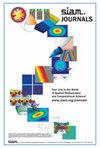多散射环境下单稳态数据的降阶建模反演
IF 2.3
3区 数学
Q3 COMPUTER SCIENCE, ARTIFICIAL INTELLIGENCE
引用次数: 0
摘要
SIAM 影像科学期刊》第 17 卷第 1 期第 334-350 页,2024 年 3 月。摘要:数据驱动的降阶模型(ROMs)最近已成为解决反向散射问题的有效工具,并应用于地震和声纳成像。这种方法的一个要求是使用全平方多输入/多输出(MIMO)矩阵值传递函数作为多维问题的数据。然而,合成孔径雷达(SAR)仅限于与矩阵传递函数对角线相对应的单输入/单输出(SISO)测量。在此,我们提出了一种基于 ROM 的李普曼-施温格方法来克服这一缺点。构建 ROM 的目的是分别匹配每对信号源-接收器的数据,然后仅使用数据驱动的格拉米安为相应的信号源构建内部解决方案。在二维和 2.5 维(三维传播和二维反射体)数值示例中演示了所提方法的效率。新算法不仅抑制了 Born 成像中出现的多重回波,还利用了它们对反射体某些背面的照亮,提高了反射体映射的质量。本文章由计算机程序翻译,如有差异,请以英文原文为准。
Reduced Order Modeling Inversion of Monostatic Data in a Multi-scattering Environment
SIAM Journal on Imaging Sciences, Volume 17, Issue 1, Page 334-350, March 2024.
Abstract.Data-driven reduced order models (ROMs) have recently emerged as an efficient tool for the solution of inverse scattering problems with applications to seismic and sonar imaging. One requirement of this approach is that it uses the full square multiple-input/multiple-output (MIMO) matrix-valued transfer function as the data for multidimensional problems. The synthetic aperture radar (SAR), however, is limited to the single-input/single-output (SISO) measurements corresponding to the diagonal of the matrix transfer function. Here we present a ROM-based Lippmann–Schwinger approach overcoming this drawback. The ROMs are constructed to match the data for each source-receiver pair separately, and these are used to construct internal solutions for the corresponding source using only the data-driven Gramian. Efficiency of the proposed approach is demonstrated on 2D and 2.5D (3D propagation and 2D reflectors) numerical examples. The new algorithm not only suppresses multiple echoes seen in the Born imaging but also takes advantage of their illumination of some back sides of the reflectors, improving the quality of their mapping.
Abstract.Data-driven reduced order models (ROMs) have recently emerged as an efficient tool for the solution of inverse scattering problems with applications to seismic and sonar imaging. One requirement of this approach is that it uses the full square multiple-input/multiple-output (MIMO) matrix-valued transfer function as the data for multidimensional problems. The synthetic aperture radar (SAR), however, is limited to the single-input/single-output (SISO) measurements corresponding to the diagonal of the matrix transfer function. Here we present a ROM-based Lippmann–Schwinger approach overcoming this drawback. The ROMs are constructed to match the data for each source-receiver pair separately, and these are used to construct internal solutions for the corresponding source using only the data-driven Gramian. Efficiency of the proposed approach is demonstrated on 2D and 2.5D (3D propagation and 2D reflectors) numerical examples. The new algorithm not only suppresses multiple echoes seen in the Born imaging but also takes advantage of their illumination of some back sides of the reflectors, improving the quality of their mapping.
求助全文
通过发布文献求助,成功后即可免费获取论文全文。
去求助
来源期刊

SIAM Journal on Imaging Sciences
COMPUTER SCIENCE, ARTIFICIAL INTELLIGENCE-COMPUTER SCIENCE, SOFTWARE ENGINEERING
CiteScore
3.80
自引率
4.80%
发文量
58
审稿时长
>12 weeks
期刊介绍:
SIAM Journal on Imaging Sciences (SIIMS) covers all areas of imaging sciences, broadly interpreted. It includes image formation, image processing, image analysis, image interpretation and understanding, imaging-related machine learning, and inverse problems in imaging; leading to applications to diverse areas in science, medicine, engineering, and other fields. The journal’s scope is meant to be broad enough to include areas now organized under the terms image processing, image analysis, computer graphics, computer vision, visual machine learning, and visualization. Formal approaches, at the level of mathematics and/or computations, as well as state-of-the-art practical results, are expected from manuscripts published in SIIMS. SIIMS is mathematically and computationally based, and offers a unique forum to highlight the commonality of methodology, models, and algorithms among diverse application areas of imaging sciences. SIIMS provides a broad authoritative source for fundamental results in imaging sciences, with a unique combination of mathematics and applications.
SIIMS covers a broad range of areas, including but not limited to image formation, image processing, image analysis, computer graphics, computer vision, visualization, image understanding, pattern analysis, machine intelligence, remote sensing, geoscience, signal processing, medical and biomedical imaging, and seismic imaging. The fundamental mathematical theories addressing imaging problems covered by SIIMS include, but are not limited to, harmonic analysis, partial differential equations, differential geometry, numerical analysis, information theory, learning, optimization, statistics, and probability. Research papers that innovate both in the fundamentals and in the applications are especially welcome. SIIMS focuses on conceptually new ideas, methods, and fundamentals as applied to all aspects of imaging sciences.
 求助内容:
求助内容: 应助结果提醒方式:
应助结果提醒方式:


